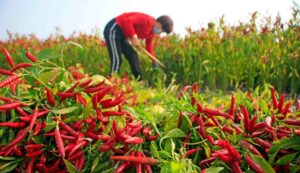Chilli farming: Government is giving subsidy to promote chilli cultivation, take advantage like this
Chilli farming: Large-scale chili cultivation is possible in Khagaria, Bihar. The government also provides farmers with subsidies for this. For farmers, receiving subsidies for growing chillies is nothing short of a blessing. Farmers get financial support via the subsidy, which enables them to lower cultivation costs and boost output. In addition, the government is subsidizing high-quality seeds at its level to increase production.

In light of this, the Horticulture Department of Bihar has recently chosen the Khagaria district to cultivate chillies. Here, farmers will get subsidies for growing chillies. To encourage the production of chillies, the government is providing farmers with financial assistance. Under this, growers would get subsidies for growing hybrid chillies on each plant.
35 hectares will be used for the growth of chillies.
Speaking about the program, Khagaria district’s assistant horticulturist, Yashwant Kumar, said that the district’s goal of growing chillies on 35 hectares had been met. One hectare requires 300 kg of seeds, which the government estimates would cost Rs 13,500. The farmers will get a 75% subsidy in such a scenario. Farmers will be required to pay 25% of the costs. Farmers may get in touch with the district horticulture office or the block horticulture officer that is closest to them to take advantage of this program’s advantages.
Use this page to apply online.
Let us inform you that farmers must apply online at https://horticulture.bihar.gov.in, the department’s website, in order to get the advantages of the program. The genealogy created by the Sarpanch must be provided throughout the application process if the farmer does not have the field receipt in their name. Farmers will need to apply online with their picture after registering on the DBT portal. In terms of market prices, a kilogram of chili might cost up to 50 rupees. However, it also hits 30 rupees because of the farmers’ large output. According to farmers, this plan may succeed provided cultivation is carried out only after a market for chillies has been established.





